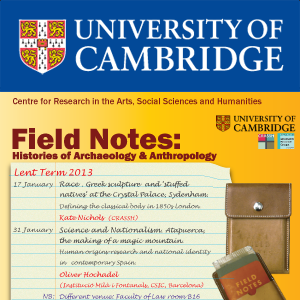Field Notes - 17 February 2014 - Beautiful Burials, Beautiful Skulls: The Aesthetics (and Ethics) of the Egyptian Mummy
Duration: 44 mins 12 secs
Share this media item:
Embed this media item:
Embed this media item:
About this item

| Description: |
Dr Christina Riggs (University of East Anglia)
Discussant: Dr Chris Wingfield (University of Cambridge) Abstract Considerations of aesthetics have played a part in studying and interpreting the ancient past since Winckelmann and Hegel, although many 20th and 21st century archaeologists may reject 'aesthetics' as a useful or productive category. In this paper - developed for the Durham-based AHRC Research Network on Ethics and Aesthetics in Archaeology - I use the ancient Egyptian mummy to argue for an ancient aesthetic that we can reconstruct through, for instance, considerations of materiality, and I contrast that to modern encounters with the Egyptian mummy, which employ a very different, and very persuasive, aesthetic based on anatomical and forensic science. What implications might this contrast have for archaeological and museological interpretations of the ancient Egyptian funerary sphere, including debates around the ethics of curating and researching human remains? |
|---|
| Created: | 2014-02-27 09:55 |
|---|---|
| Collection: | Field Notes Seminar |
| Publisher: | University of Cambridge |
| Copyright: | Glenn Jobson |
| Language: | eng (English) |
| Keywords: | CRASSH; Field Notes; |
| Abstract: | Dr Christina Riggs (University of East Anglia)
Discussant: Dr Chris Wingfield (University of Cambridge) Abstract Considerations of aesthetics have played a part in studying and interpreting the ancient past since Winckelmann and Hegel, although many 20th and 21st century archaeologists may reject 'aesthetics' as a useful or productive category. In this paper - developed for the Durham-based AHRC Research Network on Ethics and Aesthetics in Archaeology - I use the ancient Egyptian mummy to argue for an ancient aesthetic that we can reconstruct through, for instance, considerations of materiality, and I contrast that to modern encounters with the Egyptian mummy, which employ a very different, and very persuasive, aesthetic based on anatomical and forensic science. What implications might this contrast have for archaeological and museological interpretations of the ancient Egyptian funerary sphere, including debates around the ethics of curating and researching human remains? |
|---|---|

